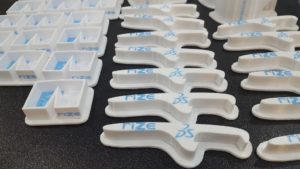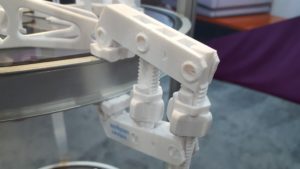 For a new technology to truly take hold, a movement requires momentum; the greatest ideas will, without being put into use, wither away and gather dust. Additive manufacturing is gaining traction, with no time for dust to settle as innovation continues at a fast pace. Still, significant barriers to adoption are holding back the rates at which traditional machine shops and other manufacturing facilities and potential users might bring 3D printing into their workflow. The question of how to bring advanced techniques into established operations, particularly among traditionally risk-averse user populations, is a big one looming large over the 3D printing industry. The fact, however, that it is being asked at all is a major advantage, as solutions are sought. During last week’s SOLIDWORKS World in LA, a major conversation taking place throughout the event was one of integration, often, specifically, of 3D printing. From rethinking this next Industrial Revolution as an Industry Renaissance to deepening partnerships to bring the broad SOLIDWORKS user base the tools for additive manufacturing, a maturing 3D printing industry is finding a path toward wider adoption — and the promised disruption.
For a new technology to truly take hold, a movement requires momentum; the greatest ideas will, without being put into use, wither away and gather dust. Additive manufacturing is gaining traction, with no time for dust to settle as innovation continues at a fast pace. Still, significant barriers to adoption are holding back the rates at which traditional machine shops and other manufacturing facilities and potential users might bring 3D printing into their workflow. The question of how to bring advanced techniques into established operations, particularly among traditionally risk-averse user populations, is a big one looming large over the 3D printing industry. The fact, however, that it is being asked at all is a major advantage, as solutions are sought. During last week’s SOLIDWORKS World in LA, a major conversation taking place throughout the event was one of integration, often, specifically, of 3D printing. From rethinking this next Industrial Revolution as an Industry Renaissance to deepening partnerships to bring the broad SOLIDWORKS user base the tools for additive manufacturing, a maturing 3D printing industry is finding a path toward wider adoption — and the promised disruption.
“How do we make 3D printing immersive in the experience of engineers?”
CEO Andy Kalambi posed this question when we met at Rize‘s booth during SWW18. For Rize, part of the answer is collaborative, as reflected in the announcement of a SOLIDWORKS add-in.
During day zero of the event, I was chatting with Kalambi and the team when SOLIDWORKS CEO Gian Paolo Bassi stopped by for a look at the up-and-running add-in. The integration, building on Rize’s relationship with SOLIDWORKS and its parent company Dassault Systèmes, marked a milestone for Rize.
The Rize One 3D printer, which famously requires virtually no post-processing and produces high-strength parts, is an industrial desktop machine that can safely work in an office environment. The vision is that an engineer can have the 3D printer running throughout the workday, close at hand. The problem, though, is that many people don’t yet think that 3D printing is really meant for them; an engineer may be great at design but balk at being expected to run new machinery.
“The whole process needs to have less friction,” Kalambi told me. “If you want the engineer to be empowered, if you want him or her to have the additive experience and not just the design experience, all of it needs to be in the hands of the engineer. It should be a one-step process. All that should happen immersively.”
And it is this idea that is at the heart of Rize’s work with SOLIDWORKS.
“Exporting to SOLIDWORKS, we’re trying to make the user experience more immersive, easier,” Rize Vice President of Marketing Julie Reece told me of the motivation.
It had been just one year before, at SWW17, that I first went hands-on with Rize and snapped off supports from one of their 3D printed parts myself. The process was as easy as they say, with supports gone in less than half a minute. Since then, I’ve had the opportunity to see more of Rize’s technology and operations, including a visit to the company’s Boston HQ, to learn still more about the vision for bringing strong 3D printing to more users who can benefit. Key to the philosophy at Rize are the ideas of sustainability and inclusion in manufacturing; with Kalambi’s leadership, these tenets are rising to an even more prominent stage. These philosophies, along with the strength of technology, are continuing to lead to growth, as Reece noted that at SWW18 the company was busy signing partners, both domestically and globally.
“I think users still see 3D printing a step away,” Kalambi said of their efforts to enhance visibility. “They still see it as they send their design to a lab and get a part back a day later — or two days, or two weeks, or longer. I want to see that be smoother, not just for Rize, but for 3D printing.”
He continued of the bigger picture,”There are good examples here of inclusive design. Inclusion is about access: how do you give access to people who haven’t had it before? This is part of our mission. You can’t have too much complexity in the process, it needs to be simpler. Sometimes we get so into our own technology we create that we can all forget it can be complex for users.”
For those working with a technology day-in-day-out, it can indeed be easy to assume that everyone has taken a deep dive; the reality is that not everyone is familiar with additive manufacturing. Integrating with SOLIDWORKS offers the opportunity for 3D printing companies to gain access to an existing large user base, and many companies announced partnerships last week aiming at that goal, to make the process of prototyping and production with additive technologies seamless.
That spirit of collaboration so often exemplified across the 3D printing industry was a major focus throughout SWW18 — and is one that is so necessary to keep the industry moving forward.
“The more we enable people to make parts with less effort, less work, less time, the more this energy keeps going, and this enthusiasm for SOLIDWORKS,” Kalambi said.
“We need to work together. We all work at different points of the value stream — we need to see from the customers’ eyes. It’s about letting the customer do his job better. We are putting a jigsaw together, and must let the customer see the big picture. Manufacturers aren’t all competing against each other. It takes us all.”
As 3D printing continues to grow, it truly will take a village to raise this industry to the profile it can ultimately reach, to be a vehicle for the promised disruption to manufacturing. As Rize and its inclusivity-focused collaborations continue to exemplify, partnership and the sharing of ideas will lead to the next stages of progress, of adoption. The road to revolution — or to renaissance, as SOLIDWORKS’ CEO put it — is paved with time and effort, and leads to a new world of possibilities.
Discuss partnerships, integration, and other 3D printing topics at 3DPrintBoard.com or share your thoughts below.
[All photos: Sarah Goehrke]
Subscribe to Our Email Newsletter
Stay up-to-date on all the latest news from the 3D printing industry and receive information and offers from third party vendors.
You May Also Like
3D Printing News Briefs, April 13, 2024: Robotics, Orthotics, & Hypersonics
In 3D Printing News Briefs today, we’re focusing first on robotics, as Carnegie Mellon University’s new Robotics Innovation Center will house several community outreach programs, and Ugogo3D is now working...
Rail Giant Alstom Saves $15M with 3D Printing Automation Software 3D Spark
3D Spark has entered into a three-year deal with the rail giant Alstom. Alstom, a transport behemoth with annual revenues of $16 billion, specializes in the manufacture of trains, trams,...
Meltio Expands Global Reach with New Partnerships in the Americas and Europe
Spanish 3D printing manufacturer Meltio has expanded its sales network across the globe. With the addition of three new partners in the United States, Brazil, Argentina, and Italy, Meltio aims...
3D Printing Webinar and Event Roundup: April 7, 2024
Webinars and events in the 3D printing industry are picking back up this week! Sea-Air-Space is coming to Maryland, and SAE International is sponsoring a 3D Systems webinar about 3D...








































